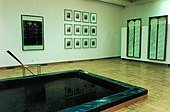Bunkier Sztuki
The Bunkier Sztuki is an exhibition building built in 1965 in the brutalist style in Krakow's Old Town and the seat of the city's modern art gallery Galeria Sztuki Współczesnej Bunkier Sztuki w Krakowie .
building
The building, designed as an exhibition center with 1,000 m² of exhibition space, was built in the early 1960s in Kraków's old town according to a design by the architect Krystyna Tołłoczko-Różyska, who incorporated an adjoining granary from the 18th century into the new building. As the only modern building between the historic buildings of the old town until 1989, the Bunkier Sztuki caused controversy for a long time. The building in the style of Brutalism has a typical facade made of dark concrete, on which the structure of the irregular wooden cladding emerges. The facade design was designed by Stefan Borzęcki and Antoni Hajdecki. In the upper area, narrow window slits were inserted, which were later covered from the inside and thus reinforced the bunker-like impression. On the occasion of an exhibition to mark the 50th anniversary of the Bunkier Sztuki, the window slits, which had been covered for 25 years, were opened in 2016 and the exhibition rooms were converted so that a new exhibition pavilion was created inside. The vaulted cellars of the previous building, an old coffee house, are also used as exhibition space.
gallery
After the opening in September 1965 to 1989, mainly artists from Krakow and southern Poland were exhibited. The artistic program until 1994 consisted mostly of exhibitions by members of the Kraków branch of the Association of Polish Artists and Designers (ZPAP) ( Związek Polskich Artystów Plastyków ) and the Association of Polish Photographers (ZPAF) ( Związek Polskich Artystów Fotografików ) as well as traveling exhibitions such as zu Folk crafts, medal engraving, interior design, Russian or Romanian art. After that, the gallery was one of the first to show works by well-known foreign artists such as Henry Moore and Hans Arp in Poland . From 2002 to 2010 the art historian and art theorist Maria Anna Potocka directed the gallery. Since 2007 an artistic-pedagogical project has brought contemporary art to children and young people.
The artistically independent cultural institution is funded by the City of Krakow. In addition to changing exhibitions of contemporary art and works by young artists, the gallery shows works from its own collection, such as Olaf Breuning, Rafał Bujnowski, Bogna Burska, Tomasz Ciecierski , Oskar Dawicki, Marta Deskur, Wojtek Doroszuk, Edward Dwurnik , Katarzyna Górna, Aleksander Janicki, Andreas M . Kaufmann, Karolina Kowalska, Lidka Krawczyk, Wojtek Kubiak, Piotr Lutynski, Marcin Maciejowski , Małgorzata Markiewicz, Zbigniew Rabsztyn, Józef Robakowski , Wilhelm Sasnal , Jadwiga Sawicka, Wael Shawky , Jan Simon, Łukasz Skąpski, Mikołaj Smoczyński, Marek Sobczyk, Jacek Tylicki , Krzysztof Wodiczko , Alicja Żebrowska.
Exhibitions (selection)
- 2019: Richard Mosse
- 2017: Ines Doujak
- 2016: You can see all the hills from my window . Exhibition on the 50th anniversary of the history and intention of the building as well as the importance of the gallery for art
- 2013: Sławomir Elsner
- 2013: Łukasz Surowiec
- 2013: Olaf Brzeski
- 2007: Maria Pinińska-Bereś
- 2006: Otto Zitko
- 2006: Beat Streuli
- 2006: Transculture Adrian Paci
- 2005: Josef Dabernig
- 2005: Jean Otth
- 2005: Oskar Dawicki
- 2005: Hans Aichinger
- 2004: Zofia Kulik
- 2003: Roland Schefferski
- 2002: Waltraud Munz
- 2001: Julita Wójcik
- 2000: Zbigniew Warpechowski
- 1996: Grzegorz Sztwiertnia
- 1995: Wincenty Dunikowski-Duniko
- 1995: Tomasz Vetulani
- 1995: Tassilo Blittersdorff
- 1988: Zbigniew Rabsztyn
Web links
Individual evidence
- ^ A b Polish Tourist Office Berlin: Jubilee of the Krakow Art Bunker
- ↑ State Archives Archiwum Narodowe w Krakowie: bunkier sztuki architecture
- ^ State archive Archiwum Narodowe w Krakowie: bunkier sztuki about
- ↑ Krakow Museums: Gallery of Contemporary Art "Art Bunker"
- ↑ State Archives Archiwum Narodowe w Krakowie: bunkier sztuki collections
- ↑ Anna Lindh Foundation: Contemporary Art Gallery Bunkier Sztuki in Krakow (Galeria Sztuki Współczesnej Bunkier Sztuki w Krakowie)
- ↑ State Archives Archiwum Narodowe w Krakowie: bunkier sztuki wystawy



